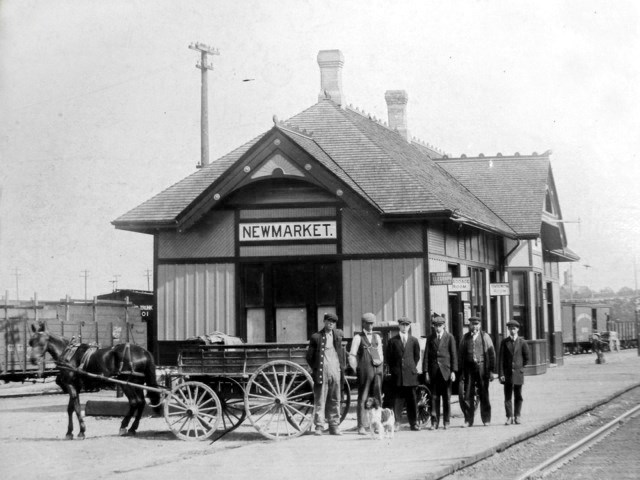As a young boy, I used to love to stand on the Queen Street bridge and watch the train go by, particularly the trains making their way across the country, and dream of places far, far away.
This week, let’s look at the Grand Trunk Railway (GTR) and its descendant, the Canadian National Railway (CNR), and our rail station on Davis Drive, recalling their place in our history.
Did you know the first railway in Upper Canada went through Newmarket? It was the third railway north of the United States border — the other two being in Quebec. Its charter named it the Ontario, Simcoe & Huron Railroad but it was soon dubbed locally the Oats, Straw and Hay Railroad. In 1858 it changed its name to the Northern Railway and, in 1888, it became the Grand Trunk Railway. It was eventually absorbed as part of the Canadian National Railway.
On May 16, 1853, the first train ran from Toronto to Aurora and on a Saturday in June 1853, the construction train arrived in Newmarket. It only went as far as the Timothy creek as there was no bridge over it at the time.
An interesting fact is that the boilers for the steam engine were often filled with the water from the pond located there, now called Fairy Lake. By the end of June, the line was opened to the Bradford bridge and later that year it was extended through Barrie to Collingwood, thus fulfilling its destiny of linking Toronto with the Upper Great Lakes.
On Aug. 4, 1854, the railroad company purchased 1.44 acres of land on the north side of Huron Street (Davis Drive) for $2, and the first Newmarket Rail Station was built a little closer to Huron than the one there today. It was an ornate board-and-batten building with a large platform.
In 1866, more land was acquired and, in 1889, the Grand Trunk Railroad built a larger station, which in turn was replaced with our current building in 1900.
The interior was finished in Georgia pine with two waiting rooms, one for men and the other for women, separated by a master and freight agent’s office where the telegraph was located. A large freight shed with loading docks at the front and sides was constructed opposite the station. The sheds were demolished in May 1980.
In 1900, a glazed Saginaw brick platform reached right up to present-day Davis Drive. Today it is only the size of the station.
The advent of the railway arriving in Newmarket brought a huge transformation to the local economy of the day. The stage coaches stopped running, new markets were opened for our agricultural products and local business activity accelerated with a new direct access to Toronto. It most certainly gave an impetus for our incorporation to the status of the Village of Newmarket in 1858.
A general decline in passenger and freight traffic prompted the CNR to announce the closing of the station in March 1978, but it was eventually delayed until Oct. 10, 1981 when the last station master left.
In May 1987, the building was designated an historic site by the Ontario Heritage Foundation for its historical, architectural and environmental significance and it still stands on the north side of Davis, just east of Main Street.
You may have read my article or attended one of my presentations on the Metropolitan Electric Railway, but this line pre-dated the Metropolitan and it certainly survived long after the Met had left us.
Newmarket was already a shipping centre for local agricultural produce, but the arrival of the railway further consolidated Newmarket’s status.
The station was the embarkation and arrival spot for our local troops and that gives it even more relevance in our history. My Mom told me of going down to the station to “welcome the boys home” after the Second World War. For her, the station held both moments of joy and terrible sadness.
Our current station, the third on the site, is one of many built by the GTR at the turn of the century, however, only a few still survive today. It is a simple timber-frame building with wood cladding, representing the Queen Anne Revival style popular at the time.
Once there were ancillary buildings around it, but they, sadly, were removed over the years. All the original exterior woodwork, including scroll-sawn bargeboards, pressed panels, spool trim and signboards, were preserved and repaired over the years. In the interior, one can still see the original layout of the waiting rooms flanked by a central operator’s bay.
In March 1993, the local heritage committee were successful in preserving the building under local statute. The old railway station is now the home of the Newmarket Chamber of Commerce.
As a wee lad, the romance and adventure attached to the railroad drew me to its daily arrival in town. Why not take a moment to visit this pillar of our past with your children? Close your eyes and imagine the arrival of the trans-continental as it begins it journey west. Can you hear that train whistle blowing? Sure, you can.
Sources: The Newmarket Era; The History of Newmarket by Ethel Trewhella; The Historic Sites and Monuments of Canada – Heritage Railway Stations March 1993; Newmarket Historical Society Newsletter – May 1993; Oral History Interviews
*******NewmarketToday.ca brings you this weekly feature about our town's history in partnership with Richard MacLeod, the History Hound, a local historian for more than 40 years. He conducts heritage lectures and walking tours of local interest, as well as leads local oral history interviews. You can contact the History Hound at [email protected].



